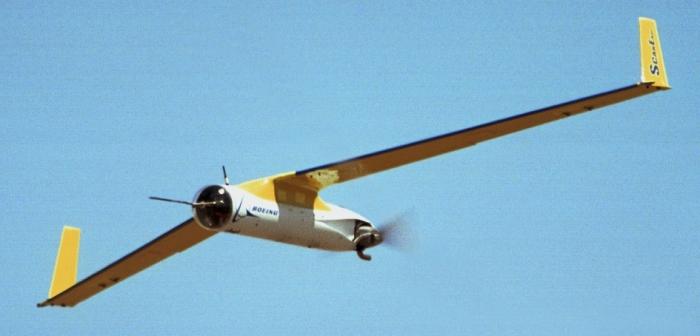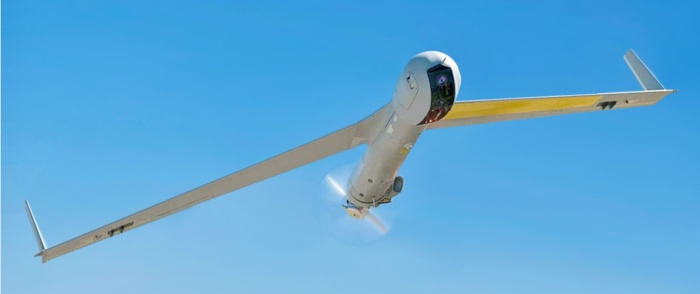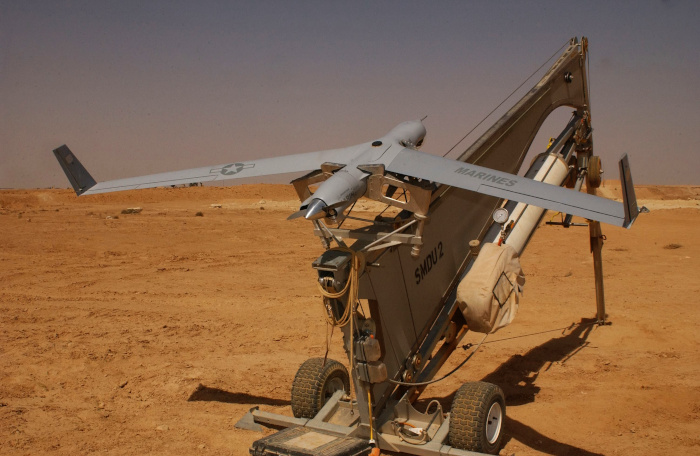Boeing/Insitu MQ-27 ScanEagle
The ScanEagle is a miniature UAV derived from the Insitu SeaScan commercial ship-based surveillance mini-UAV, which has been under development since the late 1990s. In February 2002, Boeing and the Insitu Group signed an agreement to co-develop ScanEagle, and in June that year the ScanEagle UAV conducted its first autonomous flight.
 |
| Photo: Boeing |
| ScanEagle (prototype) |
The ScanEagle is a tailless aircraft with slightly swept wings of high aspect ratio. It is powered by a tail-mounted two-stroke gasoline-fueled off-the-shelf model aircraft engine. The UAV is launched from a pneumatic catapult, and is recovered completely automatically by a so-called "Sky Hook" system, where a rope hanging from a 15 m (50 ft) pole catches the UAV. It is equipped with a GPS-based navigation system, which is used to fly autonomous missions along predefined waypoints. The production ScanEagle model, labeled ScanEagle A has demonstrated an endurance of more than 15 hours at an altitude of up to 4880 m (16000 ft). The UAV is equipped with an inertially stablized sensor turret. Standard payload is either an electro-optical and/or an infrared camera, but other sensors can be installed as well. The UAV operator views the camera images in real time, and can point and lock the camera on specific targets.
 |
| Photo: U.S. Navy |
| ScanEagle A |
In July 2004, Boeing received a contract from the U.S. Marine Corps for two mobile ScanEagle deployment units, each comprising eight ScanEagle A UAVs. The system has since been used by the USMC in Iraq, and later Afghanistan, for surveillance and reconnaissance. The U.S. Navy has also been operating the ScanEagle from various types of ships for ISR (Intelligence, Surveillance & Reconnaissance) missions since 2005. By 2012, ScanEagle had passed 600,000 combat flight hours.
 |
| Photo: Gunnery Sgt. Shannon Arledge, USMC |
| ScanEagle A (MQ-27A) |
In May 2016, more than 10 years after is was first flown by the USMC, the ScanEagle was officially designated MQ-27A. Since 2019, the Navy has also procured an MQ-27B version under its MTUAS (Multi-mission Tactical Unmanned Aircraft System) program. The MQ-27B has reportedly a higher payload capacity and improved EO/IR imaging and command/control equipment. Although the Navy has called the ScanEagle UAS an "interim" system, by 2023 it is still being used in operational roles by the Navy and Marines.
Specifications
Note: Data given by several sources show slight variations. Figures given below may therefore be inaccurate!
Data for MQ-27A:
| Length | ca. 1.6 m (5.3 ft) (depending on payload) |
| Wingspan | 3.1 m (10.2 ft) |
| Weight | max: 26 kg (58 lb) |
| Speed | 148 km/h (92 mph) |
| Ceiling | 5950 m (19500 ft) |
| Endurance | 20 h |
| Propulsion | 3W 2-stroke piston engine; 1.1 kW (1.5 hp) |
Main Sources
[1] Insitu ScanEagle Website
[2] "Unmanned Aircraft Systems Roadmap, 2005-2030", Office of the Secretary of Defense, August 2005
[3] Wikipedia: Boeing Insitu ScanEagle
[4] NAVAIR: Close Range UAS
Back to Directory of U.S. Military Rockets and Missiles, Appendix 2
Last Updated: 20 January 2024